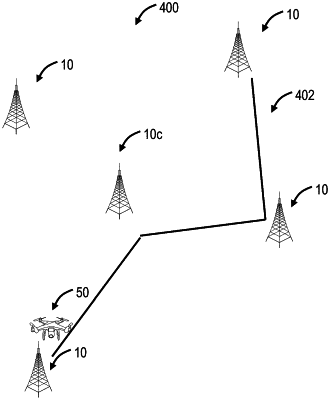| CPC G08G 5/0069 (2013.01) [B64C 39/024 (2013.01); G08G 5/0013 (2013.01); G08G 5/0034 (2013.01); B64U 10/13 (2023.01); B64U 2201/00 (2023.01)] | 18 Claims |

|
1. A flying lane management method implemented in an air traffic control system communicatively coupled to one or more passenger drones via one or more wireless networks, the flying lane management method comprising:
maintaining a continuously updated database in the air traffic control system including a plurality of waypoints that subdivide a region, a status of each of the plurality of waypoints, and a plurality of predefined flying lanes, each flying lane defining a flight path that is configured for multiple passenger drones to follow simultaneously and the flight path for each of the plurality of flying lanes is defined by multiple waypoints of the plurality of waypoints;
initiating communication to the one or more passenger drones at a preflight stage for each, wherein the communication is via one or more cell towers associated with the one or more wireless networks, wherein the one or more passenger drones each comprise hardware and antennas adapted to communicate to the one or more cell towers;
selecting a flying lane, from the plurality of predefined flying lanes for the one or more passenger drones based on a destination, current air traffic in the region under management of the air traffic control system, and based on detected obstructions in the region, the detected obstructions being identified in the status of one or more of the plurality of waypoints;
providing the flying lane to the one or more passenger drones as an approval to takeoff and fly along the flying lane;
continuing the communication during flight on the flying lane and receiving data from the one or more passenger drones, wherein the data comprises feedback during the flight;
utilizing feedback from one or more preferred passenger drones to update the flight path of at least one of the plurality of predefined flying lanes by modifying which waypoints of the region define the flight path, to update the status maintained in the database of waypoints of the plurality of waypoints, and to manage air traffic in the region, wherein preference is given to passenger drones based on reliability and accuracy; and
providing updated instructions to each of the multiple passenger drones operating in the at least one of the plurality of predefined flying lanes updated based on the updated flight path.
|